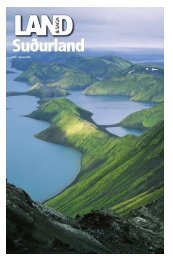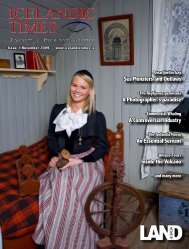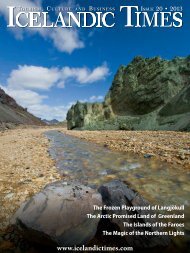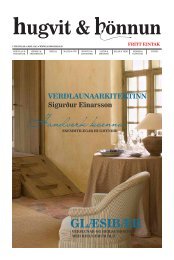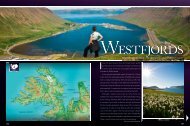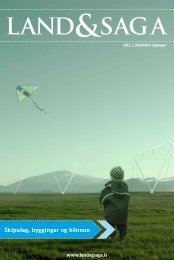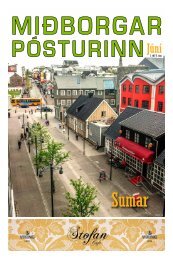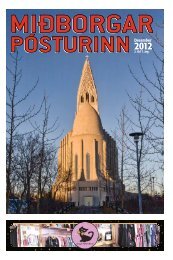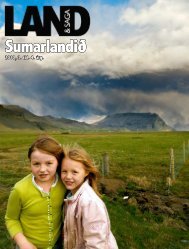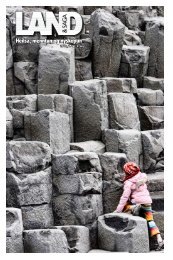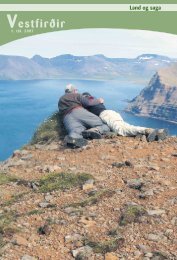You could spend your whole holiday on the ... - Land og saga
You could spend your whole holiday on the ... - Land og saga
You could spend your whole holiday on the ... - Land og saga
You also want an ePaper? Increase the reach of your titles
YUMPU automatically turns print PDFs into web optimized ePapers that Google loves.
A Cultural Metropolis<br />
Reykjanes Duus Hús combines Culture and History<br />
The often overlooked but ‘must-visit’<br />
town of Reykjanesbær is <strong>the</strong> first sign of<br />
civilisati<strong>on</strong> up<strong>on</strong> arrival in Iceland. D<strong>on</strong>’t be<br />
bluffed by <strong>the</strong> small size of <strong>the</strong> community.<br />
The wealth of activities available to visitors and<br />
locals is extensive and locals are particularly<br />
proud of <strong>the</strong>ir heritage and <strong>the</strong> intimacy <strong>the</strong>y<br />
share with <strong>the</strong> great North Atlantic Ocean<br />
crashing up<strong>on</strong> its rocky shores.<br />
The best place to discover <strong>the</strong> l<strong>on</strong>g traditi<strong>on</strong><br />
of seamanship is at <strong>the</strong> Reykjanes Art<br />
Museum located in <strong>the</strong> Duus Hús Cultural<br />
Centre, <strong>on</strong>e of Iceland’s most remarkable<br />
historical documentati<strong>on</strong>s of life in ages past.<br />
The Duus Hús Cultural Centre opened<br />
its doors in <strong>the</strong> spring of 2002 when <strong>the</strong><br />
first stage was completed. In <strong>the</strong> years to<br />
come, <strong>the</strong> Cultural Centre grew from a<br />
single c<strong>on</strong>structi<strong>on</strong> to a cluster of houses<br />
representing 100 years of architectural<br />
history in <strong>the</strong> regi<strong>on</strong>, <strong>the</strong> oldest being from<br />
1877 and <strong>the</strong> most recent <strong>on</strong>e from 1954.<br />
The choice of materials changed significantly<br />
from timber in 1877 to c<strong>on</strong>crete in 1954.<br />
Throughout history, <strong>the</strong> Duus Hús cluster<br />
has been a commercial centre for <strong>the</strong> local<br />
fi shing industry and today, it is a memorial<br />
museum celebrating <strong>the</strong> regi<strong>on</strong>’s l<strong>on</strong>g history<br />
with seamanship and fi sh processing.<br />
A Veritable Armada of Vessels<br />
The first house to open <strong>on</strong> 11 th May 2002 was<br />
Bátasalurinn, where over 100 models of <strong>the</strong><br />
Icelandic fleet have been collected. The oldest<br />
are replicas of 19 th century vessels to modern<br />
20 th century trawlers. Grímur Karlss<strong>on</strong>,<br />
a former sea captain, built <strong>the</strong> majority<br />
of <strong>the</strong> collecti<strong>on</strong>. O<strong>the</strong>r items of interest<br />
are wooden sculptures by Guðmundur<br />
Garðarss<strong>on</strong>, and souvenirs and pictures<br />
rooted in seamanship and fish processing.<br />
The World of Art<br />
Listasalurinn (art gallery) opened in April 2003<br />
and numerous local and internati<strong>on</strong>al artists<br />
have exhibited <strong>the</strong>ir work in <strong>the</strong> gallery. For<br />
instance, <strong>the</strong> summer 2012 exhibiti<strong>on</strong> was a<br />
collecti<strong>on</strong> of artwork from a large collecti<strong>on</strong><br />
bel<strong>on</strong>ging to former sea captain Matthías<br />
Matthías s<strong>on</strong> and his wife Katrín M. Ólafsdóttir.<br />
Matthías Matthías s<strong>on</strong> collected art from<br />
around <strong>the</strong> world during his travels as a captain<br />
and was a friend and a benefactor to artists in<br />
<strong>the</strong> Faroe Islands, Denmark and in Iceland.<br />
Gryfj an or <strong>the</strong> Pit Hole opened in Duus<br />
Hús <strong>on</strong> 11 th June. 2004, <strong>the</strong> day Reykjanesbær<br />
celebrated its tenth anniversary. Two years<br />
later, Bíósalurinn or <strong>the</strong> Cinema Room<br />
opened its doors for cultural activities,<br />
meetings, c<strong>on</strong>ferences, art exhibiti<strong>on</strong>s and<br />
<strong>the</strong>atre performances. Last but not least, it<br />
has served as a c<strong>on</strong>cert hall<br />
where most of <strong>the</strong> community’s local artists<br />
have performed since its opening.<br />
The last building to be incorporated<br />
into <strong>the</strong> museum is <strong>the</strong> Bryggjuhúsið or<br />
<strong>the</strong> Harbour house. It is <strong>on</strong>e of <strong>the</strong> more<br />
important buildings in <strong>the</strong> Duus Hús<br />
cluster, and <strong>the</strong> goal is to make it a mirror<br />
image of <strong>the</strong> original.<br />
To <strong>the</strong> local municipality, arts are an<br />
asset to <strong>the</strong> society of man, and <strong>the</strong> fusi<strong>on</strong><br />
of history and art makes <strong>the</strong> Duus Hús<br />
Cultural Centre a unique place to visit.<br />
Nearly 400,000 visitors have come to <strong>the</strong><br />
art museum since <strong>the</strong> opening in 2002.<br />
A Testament to <strong>the</strong> seamen of <strong>the</strong> past<br />
The Fishing Seas<strong>on</strong> (Vertíð) exhibiti<strong>on</strong> that<br />
opened in June 2012 is a documentati<strong>on</strong> of<br />
<strong>the</strong> pre-industrialised years when seamen<br />
would head out to sea <strong>on</strong> small rowboats.<br />
Workers from all corners of <strong>the</strong> country<br />
would walk l<strong>on</strong>g distances to <strong>the</strong> shores of<br />
Reykjanes where work was plentiful during<br />
<strong>the</strong> winter seas<strong>on</strong> from 2 nd February to 11 th<br />
May. As early as <strong>the</strong> early 1800’s, commercial<br />
vessels travelled to Iceland in Spring, stocked<br />
with foreign products and departed in <strong>the</strong><br />
Autumn, laden with Icelandic seafood.<br />
Toward <strong>the</strong> end of <strong>the</strong> 19 th century,<br />
merchants set up shop al<strong>on</strong>g <strong>the</strong> coast of<br />
Iceland. The new commercial centre became<br />
<strong>the</strong> heart of small coastal communities<br />
erected as a result of <strong>the</strong> industry’s<br />
expansi<strong>on</strong>. Two of <strong>the</strong> buildings in <strong>the</strong> Duus<br />
cluster are former commercial centres.<br />
Fur<strong>the</strong>r in <strong>the</strong> past: The Viking World<br />
If <strong>the</strong>re is time to spare, a visit to<br />
Víkingaheimar or Viking World is a great<br />
way to end <strong>the</strong> day. It is <strong>the</strong> place to explore<br />
Norse Mythol<strong>og</strong>y, records of famous <strong>saga</strong>s<br />
and au<strong>the</strong>ntic turf houses where early<br />
settlers lived <strong>on</strong>ce up<strong>on</strong> a time.<br />
–JB<br />
Reykjanesbær<br />
Tjarnargötu 12 • 230 Reykjanesbæ<br />
+354 421 6700<br />
reykjanesbaer@reykjanesbaer.is<br />
www.reykjanesbaer.is<br />
Reykjanesbær 109



